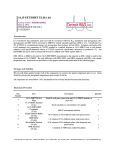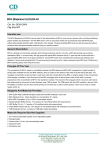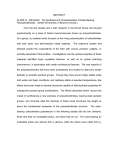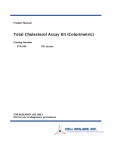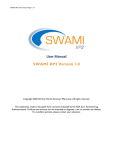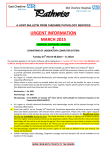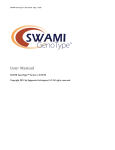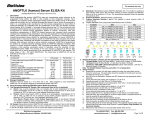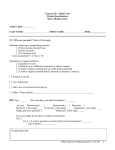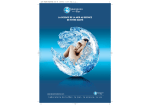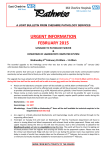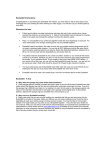Download 8-Isoprostane ELISA kit Urinary 8
Transcript
8-Isoprostane ELISA kit Urinary 8-Isoprostane ELISA kit Catalog Number: 8iso1/ 8iso11/ 8iso21/ 8iso101 8isoU1/8sioU11/8isoU21/8isoU101 Store at -20°C. FOR RESEARCH USE ONLY Introduction V.02042011 This competitive ELISA kit is for determination of 8-isoprostane levels in biological samples. The isoprostanes are a family of eicosanoids of non-enzymatic origin produced by the random oxidation of tissues phospholipids by oxygen radicals. A recent NIH-sponsored study on Biomarkers of Oxidative Stress has indicated that 8-isoprostane is the best index of oxidative injury in a well-accepted oxidant stress rat model (1,2). In addition, plasma 8isoprostane levels were found to be elevated in elderly subjects with severe hypertension (3) and in urine from subjects with high fat diet-induced liver steatosis (4). This kit can be used for the determination of 8-isoprostane in diluted urine, serum, plasma, cells, and tissues following proper isolation and purification of the eicosanoid from the isoprostane-containing sample. Instructions are provided as to the proper isolation and purification in the following pages. Storage and Stability This kit will obtain optimal results if all of the components are stored at the proper temperature prior to use. Items should be stored at the designated temperatures upon receipt of this kit. All components are stored below -20°C and should not be re-frozen and thawed more than necessary. Materials Provided Part Number 1 2 3 4 5 6 7 Item Description Quantity 8-isoprostane ELISA Plate 8-isoprotane Standard (10 ng in 2 μL) 8-isoprostane HRP Conjugates (12 μL) Sample Dilution Buffer (25 mL) HRP Buffer (15 mL) Wash Buffer Solution (25 mL) TMB Substrate (24 mL) Solid 96-well plate coated with anti 8-isoprostane antibody in each well 1 Stock standard at a concentration of 5 μg/mL 1 1000 X concentrated solution 1 10 X solution of Tris-buffered saline with preservatives 1 1 X solution of Tris-buffered saline with preservatives 1 10 X solution of Tris-buffered saline with detergents and preservatives 1 A solution of TMB (tetra methyl benzadine) 1 2727 Second Ave. Suite 4113 – Detroit, MI 48201 – tel. 313.961.1606 – fax. 313.963.7130 – [email protected] – www.detroitRandD.com Page 2 of 9 Additional Required Materials (Not Provided) Plate reader with a 450 nm filter An 8-channel adjustable pipetter and an adjustable pipetter Storage bottles Costar® cluster tubes (1.2 mL) and microcentrifuge tubes Speed-vac (optional) or argon or nitrogen gas Precautions Please read all instructions carefully before beginning the assay. The reagents in this kit have been tested and formulated to perform optimally. This kit may not perform correctly if any of the reagents are replaced or any of the procedures are modified. This kit is intended for research use only and is not to be used as a diagnostic. Procedural Notes Remove all of the reagents required, including the TMB, and allow them to equilibrate to room temperature before proceeding with the assay. It is necessary to thoroughly mix the concentrated buffer solutions. A stir bar is contained within each buffer solution. Sample Preparations There are different protocols for isolating and purifying 8-isoprostane depending on the medium it is in. Listed below are the different protocols. For optimal results follow the appropriate protocol based on the biological sample present. 8-isoprostane measurement in urine 1. Dilute urine 4-fold with sample dilution buffer containing a final concentration of ~0.1 mM TPP (triphenylphosphine, 0.03-0.05 mg/mL). TPP is an antioxidant, which looks like a precipitate in samples because it does not easily dissolve. Before using the stored samples containing TPP, spin samples to separate the precipitated TPP from sample solution. 2. Perform the ELISA for 8-isoprostane (according to the instructions of the manufacturer). 8-isoprostane measurement in cells 1. Collect and homogenize and/or sonicate the cells using a solution containing a final concentration of ~0.1 mM TPP (triphenylphosphine, 0.03-0.05 mg/mL). TPP is an antioxidant, which looks like a precipitate in samples because it does not easily dissolve. Before using the stored samples containing TPP, spin samples to separate the precipitated TPP from sample solution. 2. Acidify the whole homogenized cells with acetic acid to a pH of approximately 3-4. Measure using standard pH paper. 3. Extraction with ethyl acetate. Add an equal volume of ethyl acetate to the homogenized cells and vortex very well. Place the upper organic phase into a fresh clean tube after centrifugation. Then add another equal volume of ethyl acetate to the homogenized cells to start the second-time extraction. It is strongly recommended that extraction is performed three times. 4. Evaporate the pooled ethyl acetate from the extractions until all has dried up under argon or nitrogen gas. 5. Saponification if needed (see below) 2727 Second Ave. Suite 4113 – Detroit, MI 48201 – tel. 313.961.1606 – fax. 313.963.7130 – [email protected] – www.detroitRandD.com Page 3 of 9 6. 7. Add 10 μL to 20 μL ethanol, or N, N-dimethyl-formamide (DMF), to dissolve the dried-up residue from above step #4. Add 0.5 mL of 1x Sample Dilution Buffer (provided in kit). Load 100 μL in each well, in triplicates, on the ELISA plate. (Note: We recommend measuring a different dilution of sample in attempt to fit the results to the standard curve. e.g., add 3 wells with 50 μL of the rest of sample plus 50 μL 1x Sample Dilution Buffer and 3 wells of 10 μL of the rest of sample and 90 μL of 1x Sample Dilution Buffer.) Perform the ELISA for 8-isoprstane (according to the instructions of the manufacturer). Saponification (to cleave fatty acid from glycerol backbone): 1. Dissolve dried fatty acids after 3X ethyl acetate extractions in 20% KOH solution (make working solution: 1 mL of 2 M KOH + 4 mL methanol so that the final concentration of KOH = 0.4 N). 2. Vortex and incubate for 1 h at 50°C. 3. Add 1.5X H2O to the solution and adjust pH with 20% formic acid to pH ~5. 4. Re-extract the solution with ethyl acetate (1 part aqueous solution + 1 part ethyl acetate) and dry. 8-isoprostane measurement in tissues 1. Homogenize 1 g of tissue, 4 mL of H2O, and 0.01 mg TPP. 2. Acidify the homogenate by adding 8 μL of acetic acid to each homogenate. 3. Extract with an equal amount of ethyl acetate, vortex thoroughly, spin down, and collect the organic phase. Repeat this extraction twice more and combine all of the organic phases. 4. Dry the organic substance with argon or nitrogen gas. 5. Saponification if needed (see 8-isoprostane measurement in cells) 6. Dissolve the dried residue from above step #4 with ethanol or DMF. (Add approximately 20 μL of ethanol or DMF to reconstitute the dried-up residue.) 7. Dilute further with 1x Sample Dilution Buffer. Add approximately 0.5 mL of 1x Sample Dilution Buffer and centrifuge at 10,000 rpm for five minutes at room temperature. The supernatant will be used for ELISA measuring. 8. Perform the ELISA for 8-isoprostane (according to the instructions of the manufacturer). 8-isoprostane measurement in plasma or serum 3. Combine 1.8 mL of plasma (adjusted with approximately 20 μL of acetic acid to pH 4) and 1.8 mL of ethyl acetate. Vortex thoroughly. Centrifuge at 2000 rpm for ten minutes at 22°C. Three phases should result: i. Upper organic phase – ethyl acetate phase (lipoproteins) ii. Interphase – proteins iii. Lower phase – aqueous phase 4. Collect the upper organic phase (a) and set aside. 5. Discard the interphase. Transfer the lower phase with a glass pipette to a new tube and repeat the ethyl acetate extraction step 2 more times. 6. Evaporation of pooled organic phase: There should be approximately 5-6 mL of the ethyl acetate phase (a). Dry the pooled organic phase in a Speedvac or under argon or nitrogen gas to get the extracted sediment (b). 7. Saponification (to cleave fatty acid from glycerol backbone). Dissolve the dried residues (b) in 2 mL of 20% KOH solution (for preparation see 8-isoprostane measurement in cells). Vortex thoroughly and incubate for 1 h at 50°C. This will yield an aqueous solution (c). 8. Dilute 2 mL of the aqueous solution (c) with 3 mL of H2O. Adjust the pH using 20% formic acid (132 μL) to pH ~5.5. Add 2 mL ethyl acetate (1 part aqueous solution (c) + 1 part ethyl acetate), vortex thoroughly, and centrifuge at 2000 rpm for ten minutes at 22°C. Repeat the procedure twice more using an equal volume of ethyl acetate per sample. Collect the upper phase with saponified lipids. 9. Dry the pooled ethyl acetate upper phase (d) in a Speedvac or under argon or nitrogen gas, yielding the dried sample-sediment (e). Store the sediment (e) at -20°C. For ELISA assay, dissolve the sediment (e) in 20 μL of ethanol, then add 130 μL of 1x Sample Dilution Buffer. 10. For the competitive 8-isoprostane ELISA, the above 150 μL sample needs to be further diluted: Dilute 1:4 (e.g., 80 μL sample + 320 μL Sample Dilution Buffer). Check the final pH (should be pH 7.4). 2727 Second Ave. Suite 4113 – Detroit, MI 48201 – tel. 313.961.1606 – fax. 313.963.7130 – [email protected] – www.detroitRandD.com Page 4 of 9 11. When calculating the concentration, consider the dilution factor. In this case, 150 μL total sample volume from 1.8 mL plasma (12-fold concentration) and then, 80 uL sample in 400 μL SDB (5-fold dilution). Since, the samples are concentrated 2.4-fold; to get the actual concentration, you must divide by 2.4. Perform the ELISA for 8-isoprostane (according to the instructions of the manufacturer). Assay Preparations The solid 96-well plate and TMB solution are provided ready to use. The preparations of other assay reagents are detailed below. Wash Buffer: Mix the solution with a stir bar, applying low heat until a clear colorless solution is obtained. Dilute the entire contents of the Wash Buffer Concentrate (25 mL) with 225 mL of deionized water to yield a final volume of 250 mL of 1 X Wash Buffer. This can then be refrigerated for the entire life of the kit. HRP Conjugate: Dilute 1 vial of the 8-isoprostane-HRP conjugate (0.012 mL) with 12.00 mL of 1 X HRP buffer. One vial makes enough conjugate for one plate. The conjugate must be used the same day and should not be stored for later use. Standards: Label 5 microtubes as Standard 1 through Standard 5. Dilute the entire contents of Sample Dilution Stock buffer (25 mL) with 225 mL deionized water to yield a final volume of 250 mL of 1 X Sample Dilution Buffer. Spin down the enclosed 8-isoprostane standard vial (2 μL, filled with inert gas) and add 1.998 mL of Sample Dilution Buffer to obtain 2 mL of solution. Label this Standard 6. Add 1.6 mL of 1 X Sample Dilution Buffer to Standard 5; 1 mL of Sample Dilution Buffer to Standard 4; 1.6 mL of 1 X Sample Dilution Buffer into Standard 3; 1 mL of 1 X Sample Dilution Buffer into Standard 2; and 1 mL of Sample Dilution Buffer into Standard 1. Take 400 μL of Standard 6 (5 ng/mL) into Standard 5 (1 ng/mL). Take 1 mL of the Standard 5 solution into Standard 4 (500 pg/mL). From Standard 4, take 400 μL into Standard 3 (100 pg/mL). Take 1 mL of Standard 3 into Standard 2 (50 pg/mL). The last step is to add 400 μL of Standard 2 to Standard 1 (10 pg/mL). The serially diluted standards for 1 to 6 are ready for analysis from concentration 10 pg/mL to 5000 pg/mL. Samples: Samples can be directly diluted into the 1 X Sample Dilution Buffer if it is in solution. For extracted and dried samples, it is recommended to dissolve the dried-up samples with a minimal amount of ethanol of N, Ndimethyl-formanmide (DMF, 10 μL to 20 μL) and vortex well. Before ELISA assay, add 100 μL of 1 X Sample Dilution Buffer to make the stock sample solution ready for quantification with ELISA. The stock sample solution can be further diluted to a proper range of concentration for ELISA test 2727 Second Ave. Suite 4113 – Detroit, MI 48201 – tel. 313.961.1606 – fax. 313.963.7130 – [email protected] – www.detroitRandD.com Page 5 of 9 Performing the Assay Plate Setup: Each plate must contain a minimum of three blank wells (BL), three maximum binding wells (BO), and a six point standard curve (S1-S6). Each sample should be assayed in triplicate. A suggested plate format is shown below: BL BL BL B0 B0 B0 1 1 1 2 1 2 1 2 1 3 1 3 1 3 4 1 4 1 4 1 5 1 5 1 5 1 6 1 6 6 1 =BL =BO =S1—S6 =Samples Standard Dilutions Table Standards No. 6 No. 5 No. 4 No. 3 No. 2 No. 1 Final Concentration (pg/mL) 5,000 1,000 500 100 50 10 Add Sample Dilution Buffer (mL) 1.998 1.600 1.000 1.600 1.000 1.600 Serial Dilutions Procedure 2 μL of stock solution. Add 0.4 mL of No. 6 Add 1.0 mL of No. 5 Add 0.4 mL of No. 4 Add 1.0 mL of No. 3 Add 0.4 mL of No. 2 Assay Procedure Step 1: Load 200 microliters of Sample Dilution Buffer into the blank (B L) wells and 100 microliters of Sample Dilution Buffer into the maximum binding (B O) wells. Step 2: Load 100 microliters of each of the standards into the appropriate wells. Step 3: Load 100 microliters of each of the samples into the appropriate wells. Step 4: Load 100 microliters of the diluted 8-isoprostane-HRP conjugate in the BO wells, the standard wells, and the sample wells. Do NOT add HRP conjugate into the B L wells. Step 5: Incubate the plate at room temperature for two hours. Step 6: Wash the plate three times with 400 microliters of the diluted Wash Buffer per well. Step 7: After the last of the three wash cycles pat the plate dry onto some paper toweling. Step 8: Add 200 microliters of the TMB substrate to all of the wells (including BL wells). 2727 Second Ave. Suite 4113 – Detroit, MI 48201 – tel. 313.961.1606 – fax. 313.963.7130 – [email protected] – www.detroitRandD.com Page 6 of 9 Step 9: Incubate the plate at room temperature for 15-30 minutes. Step 10: Add 50 micoliters of 2 N sulfuric acid to all of the wells. Step 11: Read the plate at 450 nm. Calculating the Results Most plate readers provide data reduction software that can be used to plot the standard curve and determine the sample concentrations. If your plate reader does not have this option, then a data reduction program can be used (4 parameter of log-log curve fit). If you do not have these options, the results can be obtained manually as follows: 1. 2. 3. 4. 5. 6. Average the absorbance readings from the blanks and subtract that value from each well of the plate to obtain the corrected readings. (Note: Some plate readers do this automatically. Consult the user manual of your plate reader.) Average the corrected absorbance readings from the B O wells. This is your maximum binding. Calculate the %B/BO for Standard 1 by averaging the corrected absorbance of the two S1 wells, divide the average by the maximum binding, then multiply by 100. Repeat this formula for the remaining standards. Plot the %B/BO versus the concentration of 8-isoprostane from the standards using semi-log paper. Calculate the %B/BO for the samples and determine the concentrations, utilizing the standard curve. Multiply the concentrations obtained for each of the samples by their corresponding dilution factor. 2727 Second Ave. Suite 4113 – Detroit, MI 48201 – tel. 313.961.1606 – fax. 313.963.7130 – [email protected] – www.detroitRandD.com Page 7 of 9 Typical Results %B/B0 QC on 05/07/09 Net OD at 450 nm of Bo=1.394 30 min color development 110.0 100.0 90.0 80.0 70.0 60.0 50.0 40.0 30.0 20.0 10.0 0.0 1 10 100 1000 10000 8- Isoprostane [pg/ml] The data shown here is an example of typical results obtained using the Detroit R & D 8-isoprostane ELISA kit. These results are only a guideline, and should not be used to determine values from your samples. The user must run their own standard curve every time. BL wells BO wells = 0.14 = 1.387 Standard No. 1 No. 2 No. 3 No. 4 No. 5 No. 6 Concentration 10 pg/mL 50 pg/mL 100 pg/mL 500 pg/mL 1000 pg/mL 5000 pg/mL O.D. 1.394 1.174 0.985 0.504 0.328 0.090 %B/BO 100.0 73.4 70.7 36.2 23.5 6.4 Specificity of anti-8-isoprostane IgG The specificity of the 8-isoprostane ELISA was investigated using authentic 8-isoprostane and a panel of eicosanoids structurally similar to the 8-isoprostane. 8-isoprostane 2,3-dinor-8-isoPGF2α 2,3-dinor-11β-PGF2α PGF 1α 8-iso PGE2 8-iso PGE1 100.00 % < 0.01 % < 0.01 % < 0.01 % < 0.01 % < 0.01 % Troubleshooting No color present in standard wells. The HRP conjugate was not added. Redo the assay and add the conjugate at the proper step. 2727 Second Ave. Suite 4113 – Detroit, MI 48201 – tel. 313.961.1606 – fax. 313.963.7130 – [email protected] – www.detroitRandD.com Page 8 of 9 The HRP conjugate was not incubated for the proper time. Redo the assay and incubate for the proper time. No color in any wells, including the TA wells. The TMB substrate was not added. Add substrate. The TMB substrate was not incubated for the proper time. Continue incubation until desired color is reached. The color is faint. One or all of the incubation times were cut short. Redo the assay with the proper incubation times. The TMB substrate was not warmed up to room temperature. Redo the assay making sure all reagents are at room temperature. The lab is too cold. Be sure the lab temperature is between 21-27°C and redo the assay. The background color is very high. The TMB substrate has been contaminated. Redo the assay with a fresh bottle of substrate. Scattered O.D. obtained from the sample. Redo assay using an 8-channel pipetman making sure that 8 channels are equal volume while loading. References 1. 2. 3. 4. Morrow JD. Quantification of isoprostanes as indices of oxidant stress and the risk of atherosclerosis in humans. Arterioscler Thromb Vasc Biol. 2005; 25:279-86. Gross M, et al. Plasma F2-isoprostanes and coronary artery calcification: the CARDIA Study. Clin Chem. 2005; 51:125-31. Hozawa A, et al. Increased plasma 8-isoprostane levels in hypertensive subjects: the Tsurugaya Project. Hypertens Res. 2004; 27:557-61. Carabelli, J, et al. High fat diet-induced liver steatosis promotes an increase in liver mitochondrial biogenesis in response to hypoxia. J. Cell. Mol. Med. 2010. Warranty Detroit R&D, Inc., makes no warranty of any kind expressed, or implied, including, but not limited to the warranties of fitness for a particular purpose and merchantability. 2727 Second Ave. Suite 4113 – Detroit, MI 48201 – tel. 313.961.1606 – fax. 313.963.7130 – [email protected] – www.detroitRandD.com Page 9 of 9 Detroit R&D, Inc. Metro Center For High Technology Bldg. (MCHT) 2727 Second Ave. Suite 4113 Detroit, MI 48201 Phone: 313.961.1606 Fax: 313.963.7130 E-mail: [email protected] www.DetroitRandD.com 2727 Second Ave. Suite 4113 – Detroit, MI 48201 – tel. 313.961.1606 – fax. 313.963.7130 – [email protected] – www.detroitRandD.com











